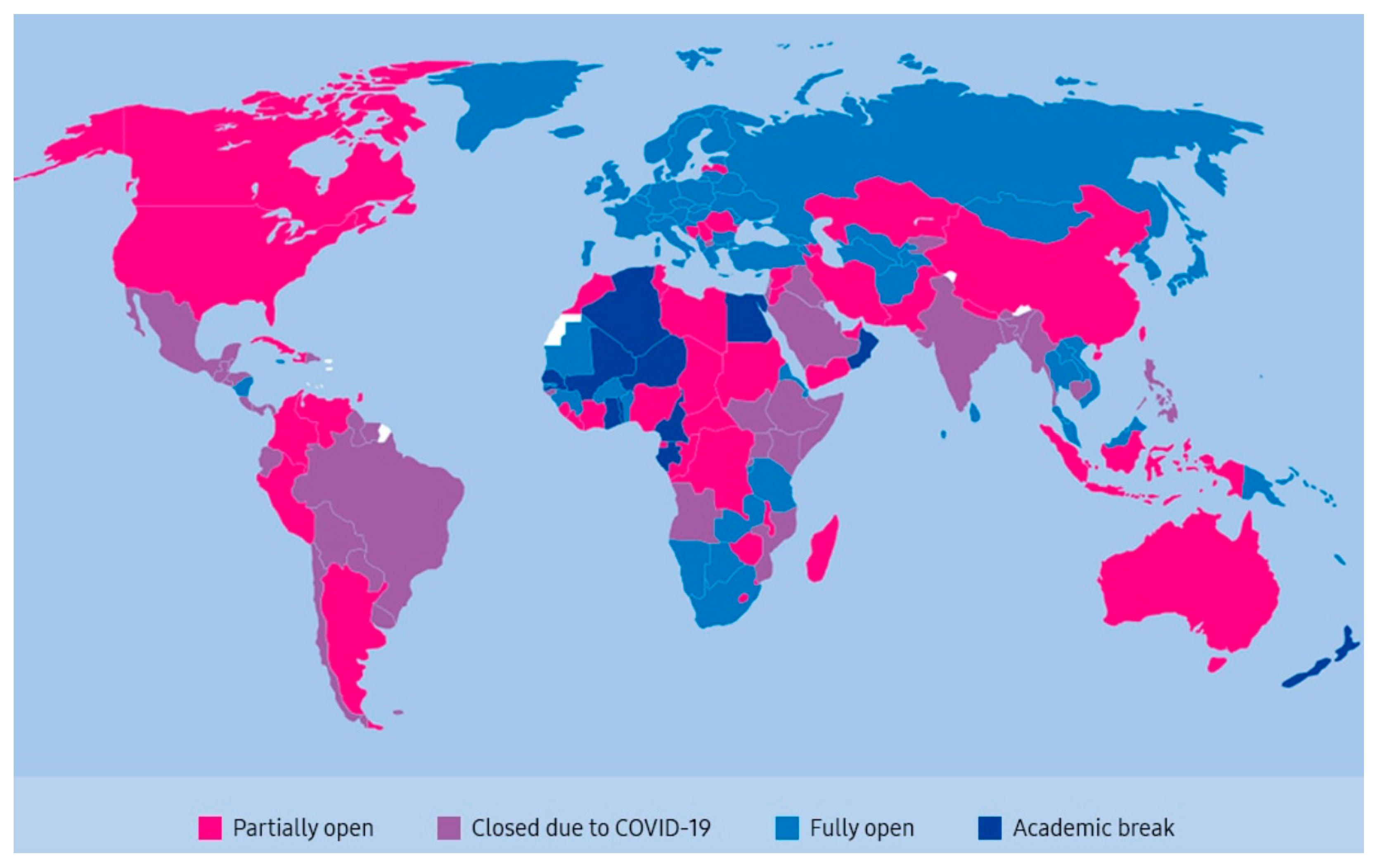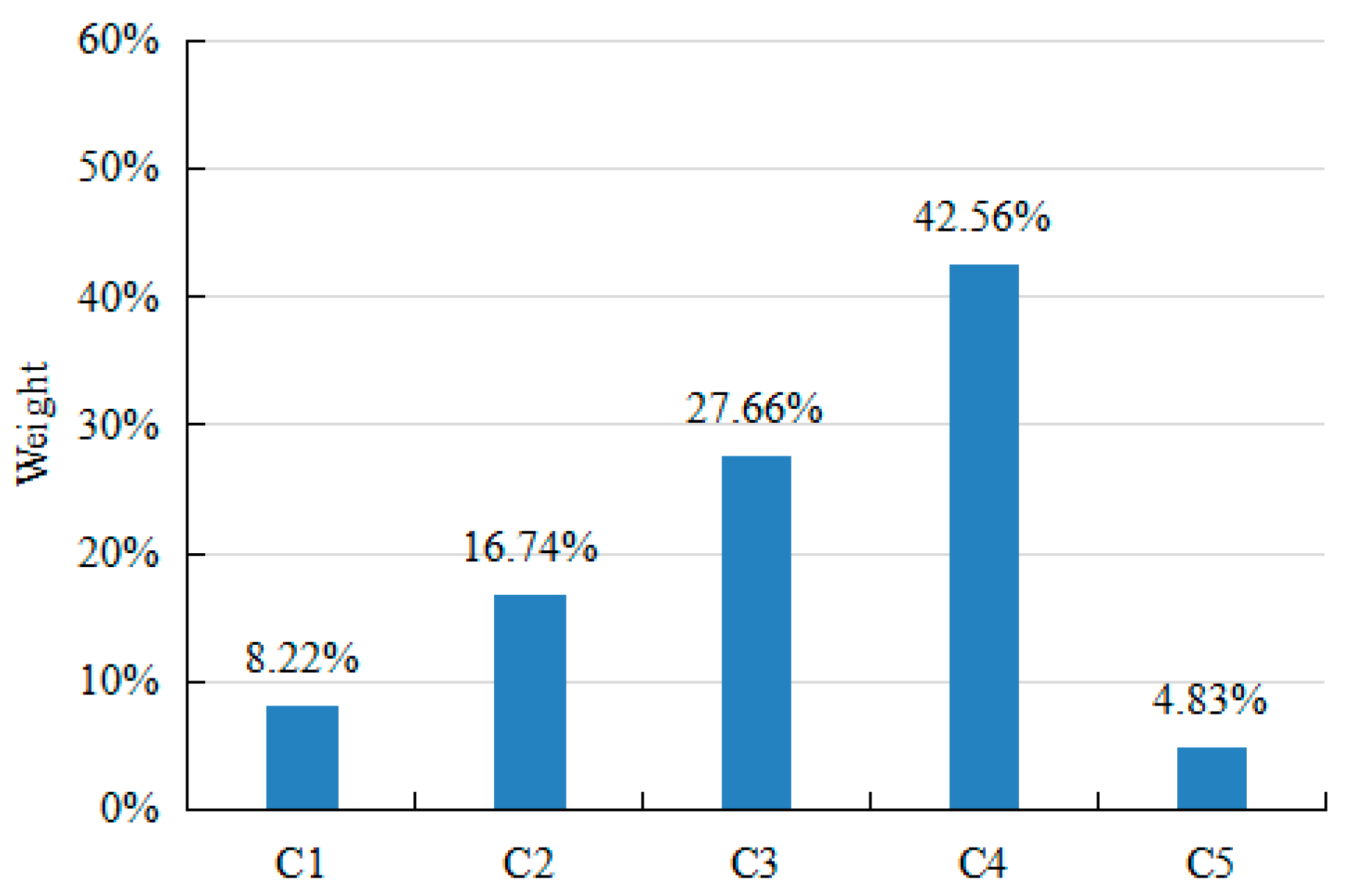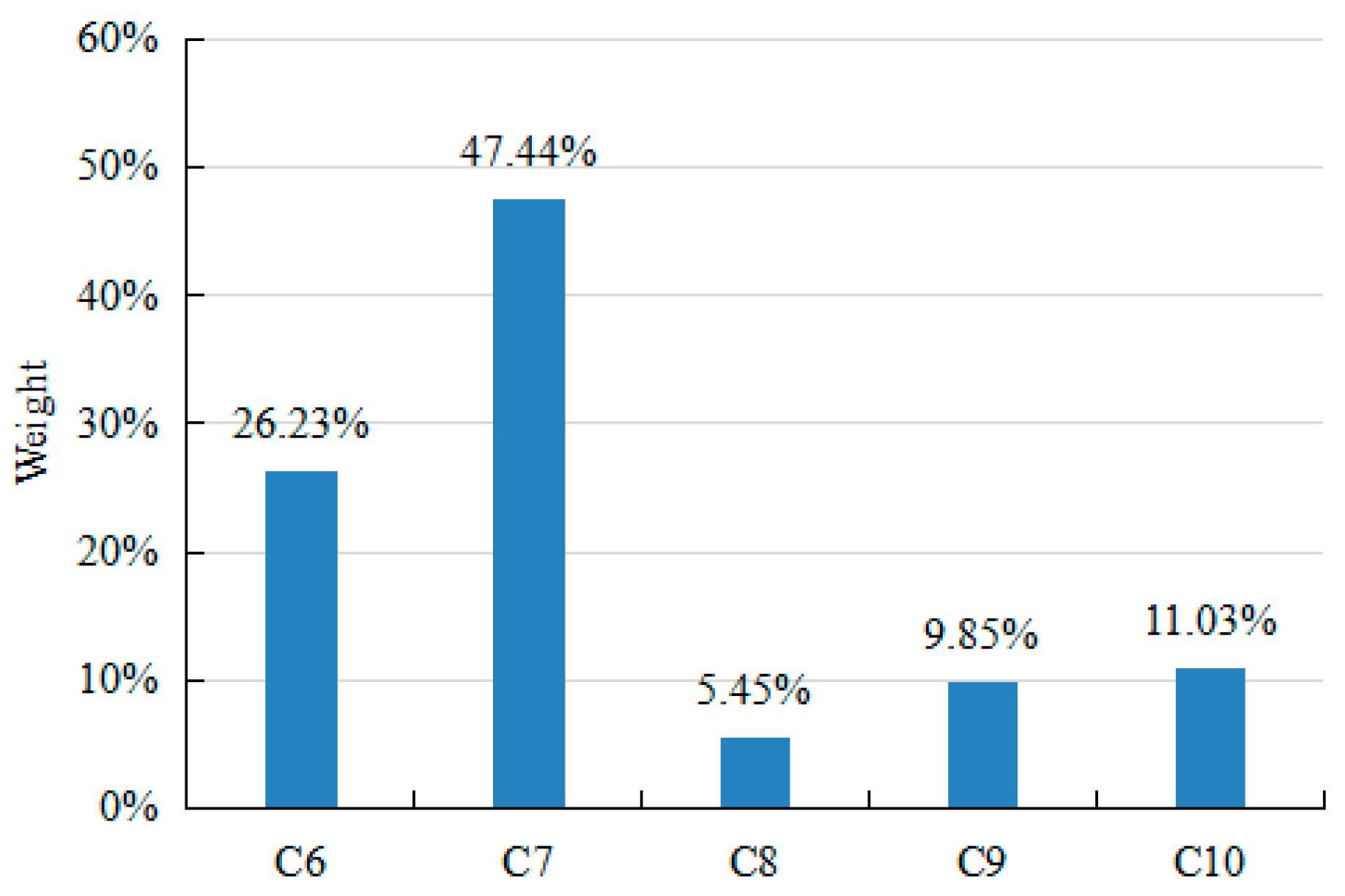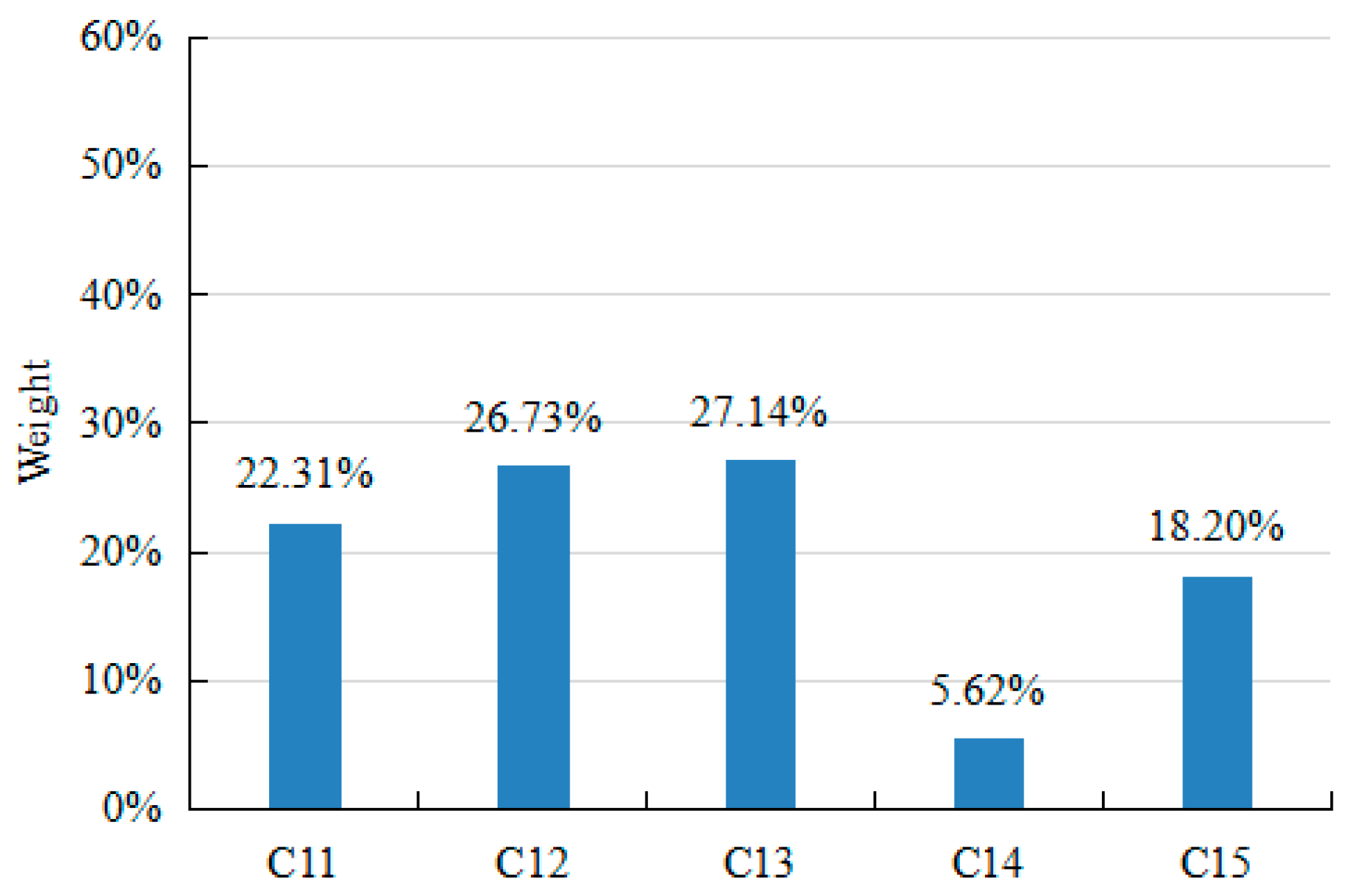Evaluating of Education Effects of Online Learning for Local University Students in China: A Case Study
Abstract
:1. Introduction
2. Methodology
2.1. Multi-Level Factor Valuation System
2.2. Determine the Weight of Each Factor
3. Case Study
4. Results and Discussion
5. Limitation and Future Work
6. Conclusions
Author Contributions
Funding
Informed Consent Statement
Data Availability Statement
Acknowledgments
Conflicts of Interest
References
- McKenzie, G.; Adams, B. A country comparison of place-based activity response to COVID-19 policies. Appl. Geogr. 2020, 125, 102363. [Google Scholar] [CrossRef] [PubMed]
- Kraft, M.A.; Simon, N.S.; Lyon, M.A. Sustaining a sense of success: The protective role of teacher working conditions during the COVID-19 pandemic. J. Res. Educ. Eff. 2021, 14, 727–769. [Google Scholar] [CrossRef]
- Mohammed, A.S. Experience sharing on virtual COOP training to mechanical engineering students during the COVID-19 pandemic. Sustainability 2021, 13, 11401. [Google Scholar] [CrossRef]
- Guo, Y.Y.; Liu, Z.J.; Meng, X.Y.; Yin, H.B. Unravelling the relationship between student engagement and learning outcomes in emergency online learning: A synthesis of quantitative and qualitative results. Assess. Eval. High. Educ. 2023, 1–14. [Google Scholar] [CrossRef]
- Pires, C. A SWOT analysis of pharmacy students’ perspectives on e-learning based on a narrative review. Pharmacy 2023, 11, 89. [Google Scholar] [CrossRef] [PubMed]
- Nesterowicz, K.; Librowski, T.; Edelbring, S. Validating e-learning in continuing pharmacy education: Aser acceptance and knowledge change. BMC Med. Educ. 2014, 14, 33. [Google Scholar] [CrossRef] [PubMed]
- Ferri, F.; Grifoni, P.; Guzzo, T. Online learning and emergency remote teaching: Opportunities and challenges in emergency situations. Societies 2020, 10, 86. [Google Scholar] [CrossRef]
- Octavian, D.; Nicoleta, D. Perception over e-learning tools in higher education: Comparative study romania and moldova. In Proceedings of the IE 2020 International Conference, Madrid, Spain, 1 February 2020; pp. 59–64. [Google Scholar] [CrossRef]
- Almaiah, M.A.; Hajjej, F.; Lutfi, A.; Al-Khasawneh, A.; Shehab, R.; Al-Otaibi, S.; Alrawad, M. Explaining the factors affecting students’ attitudes to using online learning (Madrasati Platform) during COVID-19. Electronics 2022, 11, 973. [Google Scholar] [CrossRef]
- Berchin, I.I.; de Aguiar Dutra, A.R.; Guerra, J.B.S.O.A. How do higher education institutions promote sustainable development? A literature review. Sustain. Dev. 2021, 29, 1204–1222. [Google Scholar] [CrossRef]
- Elmassah, S.; Biltagy, M.; Gamal, D. Engendering sustainable development competencies in higher education: The case of Egypt. J. Clean. Prod. 2020, 266, 121959. [Google Scholar] [CrossRef]
- Yao, C. An investigation of adult learners’ viewpoints to a blended learning environment in promoting sustainable development in China. J. Clean. Prod. 2019, 220, 134–143. [Google Scholar] [CrossRef]
- Gambo, Y.; Shakir, M.Z. Evaluating students’ experiences in self-regulated smart learning environment. Educ. Inf. Technol. 2023, 28, 547–580. [Google Scholar] [CrossRef] [PubMed]
- Jin, R.Y. European higher education quality assurance system under the bologna declaration. J. High. Educ. Manag. 2008, 2, 26–30, (In Chinese with Abstract in English). [Google Scholar] [CrossRef]
- Sun, H. A research on online learning quality evaluation and improvement based on performance oriented theory—Taking the online learning performance evaluation of students majoring in economics and management in a university in Bejing as an Example. Price Theory Pract. 2022, 452, 196–199. [Google Scholar] [CrossRef]
- Leaman, H.; Kistler, S.L. Improving learning through performance assessment in a social studies methods course for preservice elementary teachers. Srate J. 2009, 18, 70–79. [Google Scholar]
- Huang, E.Y.; Sheng, W.L.; Huang, T.K. What type of learning style leads to online participation in the mixed-mode e-learning environment? A study of software usage instruction. Comput. Educ. 2012, 58, 338–349. [Google Scholar] [CrossRef]
- Hsieh, M.Y. The Sustainable development and strategic approaches for contemporary higher education. Sustainability 2022, 14, 12925. [Google Scholar] [CrossRef]
- Wang, H.; Wu, J.; Muhedaner, M.; Maihemuti, S. College students online education evaluation through SWOT analysis during COVID-19. IEEE Access 2022, 10, 88371–88385. [Google Scholar] [CrossRef]
- Wang, L.; Hu, G.; Zhou, T. Semantic analysis of learners’ emotional tendencies on online MOOC education. Sustainability 2018, 10, 1921. [Google Scholar] [CrossRef] [Green Version]
- Wang, N.; Ren, Z.; Zhang, Z.; Fu, J. Evaluation and prediction of higher education system based on AHP-TOPSIS and LSTM neural network. Appl. Sci. 2022, 12, 4987. [Google Scholar] [CrossRef]
- Liu, Z.; Yang, H.C.; Shiau, Y.C. Investigation on evaluation framework of elementary school teaching materials for sustainable development. Sustainability 2020, 12, 3736. [Google Scholar] [CrossRef]
- Arnaldo Valdés, R.M.; Gómez Comendador, V.F. European universities initiative: How universities may contribute to a more sustainable society. Sustainability 2022, 14, 471. [Google Scholar] [CrossRef]
- Liu, Y.K.; Feng, X.P.; Chen, Y.L. The evaluation of green university based on analysis hierarchy process. Adv. Mater. Res. 2013, 726–731, 1054–1058. [Google Scholar] [CrossRef]
- Feng, B. Dynamic analysis of college physical education teaching quality evaluation based on network under the big data. Comput. Intell. Neurosci. 2021, 2021, 5949167. [Google Scholar] [CrossRef] [PubMed]
- Chen, J.; Huang, H. Analytic hierarchy process of the evaluation system of physical education teaching quality in colleges and universities. Educ. Sci. Theory Pract. 2018, 18, 6. [Google Scholar]
- Aziz, S.; Mahmood, M.; Rehman, Z. Implementation of CIPP model for quality evaluation at school level: A case study. J. Educ. Educ. Dev. 2018, 5, 189–206. [Google Scholar] [CrossRef] [Green Version]
- Barba-Sánchez, V.; Mitre-Arandab, M.; del Brío-González, J. The entrepreneurial intention of university students: An environmental perspective. Eur. Res. Manag. Bus. Econ. 2022, 28, 100184. [Google Scholar] [CrossRef]
- Fan, X.; Tian, S.; Lu, Z.; Cao, Y. Quality evaluation of entrepreneurship education in higher education based on CIPP model and AHP-FCE methods. Front. Psychol. 2022, 13, 973511. [Google Scholar] [CrossRef]
- Zhao, X.; Zheng, C. Fuzzy evaluation of physical education teaching quality in colleges based on analytic hierarchy process. Int. J. Emerg. Technol. Learn. 2021, 16, 217–230. [Google Scholar] [CrossRef]
- Walter, S.G.; Parboteeah, K.P.; Walter, A. University departments and self-employment intentions of business students: A cross-level analysis. Entrep. Theory Pract. 2013, 37, 175–200. [Google Scholar] [CrossRef]
- Toghrāyi, M.; Mirvāhedi, S.S.; Hashemi, S. Designing the entrepreneurial education model. Educ. Innov. 2019, 18, 59–82. [Google Scholar] [CrossRef]
- Saaty, T.L. The Analytical Hierarchy Process; McGraw-Hill: New York, NY, USA, 1980. [Google Scholar]
- Ramanathan, R. A note on the use of the analytic hierarchy process for environmental impact assessment. J. Environ. Manag. 2001, 63, 27–35. [Google Scholar] [CrossRef] [PubMed] [Green Version]
- Macharis, C.J.; Springael, K.; Brucker, D.; Verbeke, A. Promethee and AHP: The design of operational synergies in multi-criteria analysis. Eur. J. Oper. Res. 2004, 153, 307–317. [Google Scholar] [CrossRef]
- Saaty, T.L. Decision making with the analytic hierarchy process. Int. J. Serv. Sci. 2008, 1, 83–98. [Google Scholar] [CrossRef] [Green Version]
- Saaty, T.L. The modern science of multicriteria decision making and its practical applications: The AHP/ANP approach. Oper. Res. 2013, 61, 1101–1118. [Google Scholar] [CrossRef]
- Tsang, J.T.Y.; So, M.K.P.; Chong, A.C.Y.; Lam, B.S.Y.; Chu, A.M.Y. Higher education during the pandemic: The predictive factors of learning effectiveness in COVID-19 online learning. Educ. Sci. 2021, 11, 446. [Google Scholar] [CrossRef]
- Huang, Z.Z.; Zhang, X.L. Research on the influence mechanism of self-regulated learning on online learning outcomes—Concurrently discuss the mediation effect of online learning interaction. Mod. Educ. Technol. 2018, 28, 66–72, (In Chinese with English Abstract). [Google Scholar] [CrossRef]
- Wan, L.Y.; Shu, A. Research on the influence of interaction imbalance on college students’ burnout in online learning. Mod. Distance Educ. 2022, 200, 34–41, (In Chinese with English Abstract). [Google Scholar] [CrossRef]






| Evaluating of online learning quality for local university students in China A | Online course resources B1 | Online learning platform operation capability C1 |
| Ability to autonomously select online learning resources C2 | ||
| Enrichment of online courses C3 | ||
| Ability to arrange online learning plans C4 | ||
| Online learning exam scores C5 | ||
| Online learning ability B2 | Online learning and interactive communication skills C6 | |
| Collaborative communication skills in online learning C7 | ||
| Online learning reflection and evaluation ability C8 | ||
| Innovative thinking and abilities in online learning C9 | ||
| Online learning application ability C10 | ||
| Online learning environment B3 | Online learning network fluency C11 | |
| Stability of learning equipment C12 | ||
| The environment surrounding online learning C13 | ||
| Online learning classroom atmosphere C14 | ||
| Autonomous control in online learning C15 |
| Scale | Meaning |
|---|---|
| 1 | Indicates that two factors have the same importance |
| 3 | Indicates that one factor is less important than the other |
| 5 | Indicates that one factor is obviously more important than the other |
| 7 | Indicates that one factor is more important than the other |
| 9 | Indicates that one factor is absolutely more important than the other |
| 2, 4, 6, 8 | Represents the intermediate value of the adjacent judgment |
| Reciprocal matrix | If element i/element j = rij, then if element j/element i = 1/rij |
| Matrix order | 1 | 2 | 3 | 4 | 5 | 6 | 7 | 8 | 9 | 10 | 11 |
| RI | 0 | 0 | 0.58 | 0.90 | 1.12 | 1.24 | 1.32 | 1.41 | 1.45 | 1.49 | 1.51 |
| A | B1 | B2 | B3 |
| B1 | 1 | 1/3 | 1/2 |
| B2 | 3 | 1 | 3 |
| B3 | 2 | 1/3 | 1 |
| B1 | C1 | C2 | C3 | C4 | C5 |
|---|---|---|---|---|---|
| C1 | 1 | 1/3 | 1/5 | 1/5 | 3 |
| C2 | 3 | 1 | 1/3 | 1/3 | 5 |
| C3 | 5 | 3 | 1 | 1/3 | 5 |
| C4 | 5 | 3 | 3 | 1 | 5 |
| C5 | 1/3 | 1/5 | 1/5 | 1/5 | 1 |
| B2 | C6 | C7 | C8 | C9 | C10 |
|---|---|---|---|---|---|
| C6 | 1 | 1/2 | 4 | 3 | 3 |
| C7 | 2 | 1 | 7 | 5 | 5 |
| C8 | 1/4 | 1/7 | 1 | 1/2 | 1/3 |
| C9 | 1/3 | 1/5 | 2 | 1 | 1 |
| C10 | 1/3 | 1/5 | 3 | 1 | 1 |
| B3 | C11 | C12 | C13 | C14 | C15 |
|---|---|---|---|---|---|
| C11 | 1 | 1 | 1 | 4 | 1 |
| C12 | 1 | 1 | 2 | 4 | 1 |
| C13 | 1 | 1/2 | 1 | 5 | 3 |
| C14 | 1/4 | 1/4 | 1/5 | 1 | 1/3 |
| C15 | 1 | 1 | 1/3 | 3 | 1 |
| λmax | CI | RI | CR | Consistency Inspection Results |
|---|---|---|---|---|
| 3.054 | 0.027 | 0.520 | 0.052 | Pass |
| λmax | CI | RI | CR | Consistency Inspection Results |
|---|---|---|---|---|
| 5.397 | 0.099 | 1.120 | 0.089 | Pass |
| λmax | CI | RI | CR | Consistency Inspection Results |
|---|---|---|---|---|
| 5.073 | 0.018 | 1.120 | 0.016 | Pass |
| λmax | CI | RI | CR | Consistency Inspection Results |
|---|---|---|---|---|
| 5.266 | 0.067 | 1.120 | 0.059 | Pass |
| First-Level Factor A | Second-Level Factors (B1~B3) and Weights | Third-Level Factors (C1~C15) and Weights | ||
|---|---|---|---|---|
| Evaluating of online learning quality for local university students in China A | Online course resources B1 | 0.1593 | Online learning platform operation capability C1 | 0.0822 |
| Ability to autonomously select online learning resources C2 | 0.1674 | |||
| Enrichment of online courses C3 | 0.2766 | |||
| Ability to arrange online learning plans C4 | 0.4256 | |||
| Online learning exam scores C5 | 0.0483 | |||
| Online learning ability B2 | 0.5899 | Online learning and interactive communication skills C6 | 0.2623 | |
| Collaborative communication skills in online learning C7 | 0.4744 | |||
| Online learning reflection and evaluation ability C8 | 0.0545 | |||
| Innovative thinking and abilities in online learning C9 | 0.0985 | |||
| Online learning application ability C10 | 0.1103 | |||
| Online learning environment B3 | 0.2519 | Online learning network fluency C11 | 0.2231 | |
| Stability of learning equipment C12 | 0.2673 | |||
| The environment surrounding online learning C13 | 0.2714 | |||
| Online learning classroom atmosphere C14 | 0.0562 | |||
| Autonomous control in online learning C15 | 0.1820 | |||
Disclaimer/Publisher’s Note: The statements, opinions and data contained in all publications are solely those of the individual author(s) and contributor(s) and not of MDPI and/or the editor(s). MDPI and/or the editor(s) disclaim responsibility for any injury to people or property resulting from any ideas, methods, instructions or products referred to in the content. |
© 2023 by the authors. Licensee MDPI, Basel, Switzerland. This article is an open access article distributed under the terms and conditions of the Creative Commons Attribution (CC BY) license (https://creativecommons.org/licenses/by/4.0/).
Share and Cite
Bai, L.; Yang, B.; Yuan, S. Evaluating of Education Effects of Online Learning for Local University Students in China: A Case Study. Sustainability 2023, 15, 9860. https://doi.org/10.3390/su15139860
Bai L, Yang B, Yuan S. Evaluating of Education Effects of Online Learning for Local University Students in China: A Case Study. Sustainability. 2023; 15(13):9860. https://doi.org/10.3390/su15139860
Chicago/Turabian StyleBai, Lifen, Binbin Yang, and Shichong Yuan. 2023. "Evaluating of Education Effects of Online Learning for Local University Students in China: A Case Study" Sustainability 15, no. 13: 9860. https://doi.org/10.3390/su15139860
APA StyleBai, L., Yang, B., & Yuan, S. (2023). Evaluating of Education Effects of Online Learning for Local University Students in China: A Case Study. Sustainability, 15(13), 9860. https://doi.org/10.3390/su15139860






